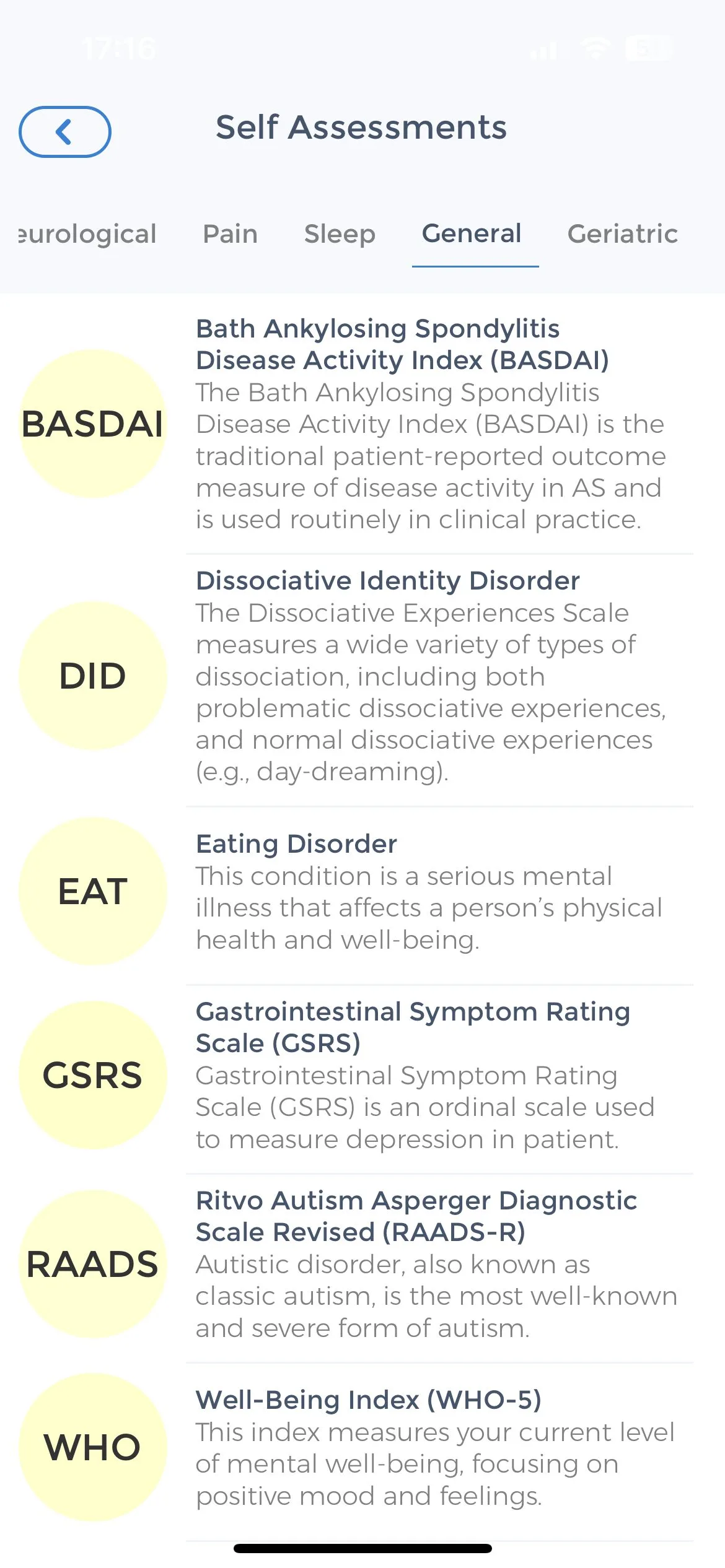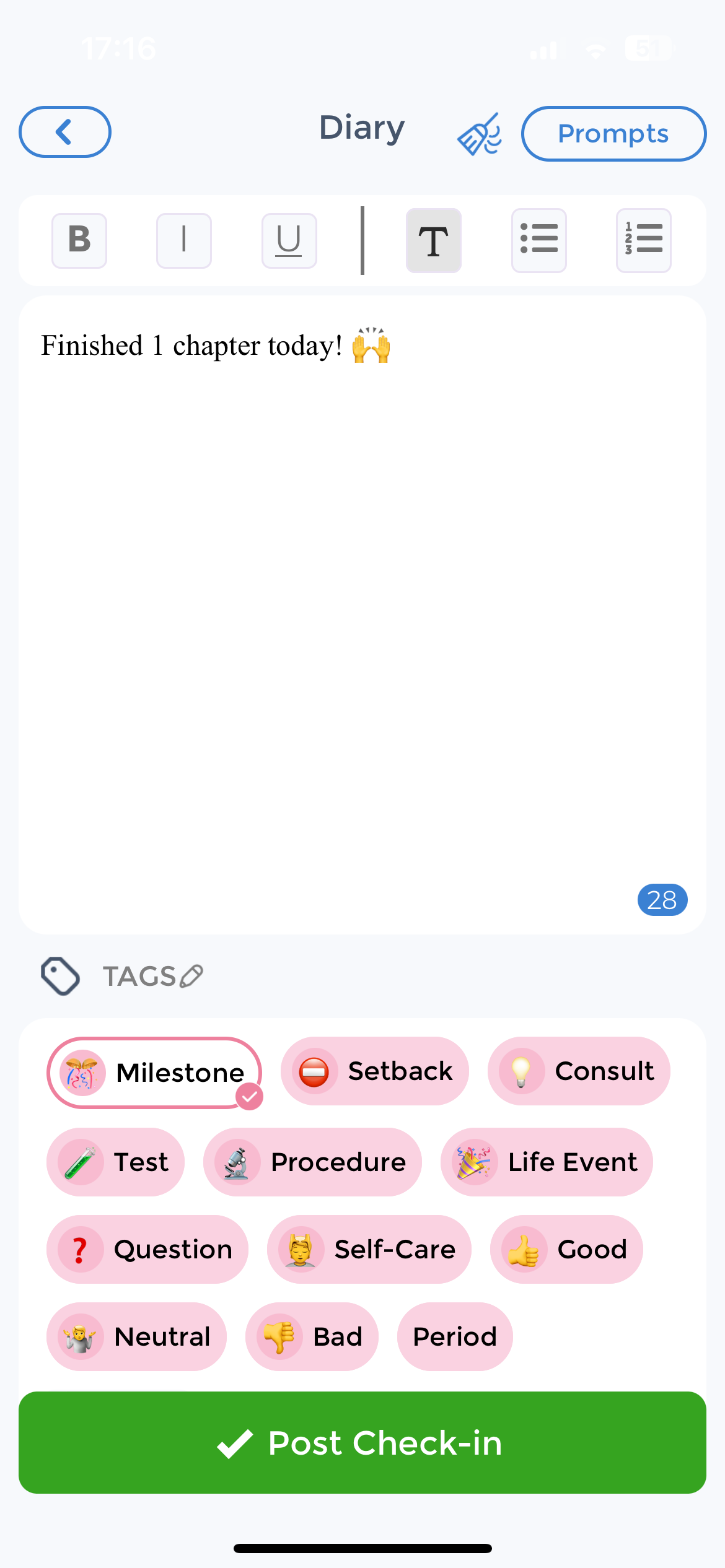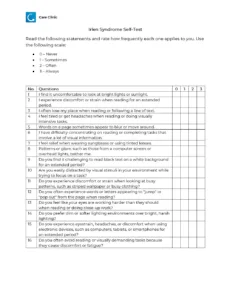
Irlen Syndrome is a visual processing disorder that affects how the brain perceives and interprets visual information. Individuals with this condition may experience a range of symptoms, including difficulty reading, sensitivity to light, and headaches. While it can be challenging to diagnose Irlen Syndrome, there are specific tests and self-tests available to help identify this condition. It provides individuals with appropriate interventions and support for the Irlen method.[1][2][3]
Printable Irlen Syndrome Test
⬇️ Irlen Syndrome Test PDF Printable[4][5]
Understanding Irlen Syndrome
Irlen Syndrome, also known as scotopic sensitivity syndrome or visual stress. A perceptual processing disorder that primarily affects the brain’s ability to process visual information. It is not related to any existing eye conditions and cannot be detected through standard eye examinations. Individuals with Irlen Syndrome may experience a range of symptoms, such as:
- Difficulty reading or writing
- Sensitivity to bright lights or glare, and easily distracted
- Migraines or headaches, and feel dizzy
- Eye strain or discomfort
- Squinting or rubbing the eyes
- Skip words or line,s or lose place while reading
- Tend to reread lines and pages multiple times
These symptoms can significantly impact a person’s daily life. Making it challenging to perform tasks that require visual focus and concentration. Imagine trying to read a page of a book, but the lines and words constantly blur or move on the page, causing frustration and fatigue. Individuals with Irlen Syndrome often face these difficulties. This can affect their academic performance, work productivity, and overall quality of life.
Causes and Risk Factors of Irlen Syndrome
The exact cause of Irlen Syndrome is still not fully understood. However, it is believed to be related to a problem with the way the brain processes visual stimuli. Specifically, certain wavelengths of light. Research suggests that genetic factors and a history of head injuries or concussions may increase the risk of developing Irlen Syndrome.
Genetic factors play a role in various aspects of our health, and Irlen Syndrome is no exception. Studies have shown that individuals with a family history of the condition are more likely to develop it themselves. This suggests that there may be specific genes involved in the susceptibility to Irlen Syndrome.
Furthermore, head injuries or concussions have been identified as potential risk factors for developing Irlen Syndrome. Trauma to the head can disrupt the brain’s visual processing abilities. Leading to the manifestation of symptoms associated with the condition. It is crucial to take head injuries seriously and seek appropriate medical attention to minimize the potential long-term effects.
While the causes and risk factors of Irlen Syndrome are still being explored, it is essential to raise awareness about this condition and provide support for individuals who experience its impact. By understanding the challenges faced by those with Irlen Syndrome, we can work towards creating a more inclusive and accommodating environment for everyone.
Early Detection and Diagnosis
Early detection and diagnosis of Irlen Syndrome are crucial for individuals experiencing visual processing difficulties. Identifying this condition allows for appropriate interventions and support to be implemented, enhancing academic and daily life functioning. The test offers a comprehensive assessment to diagnose and understand the specific visual challenges faced by individuals.
Impact on Learning and Daily Life
Irlen Syndrome can significantly impact an individual’s learning abilities and overall quality of life. Difficulties with reading, writing, and visual processing can hinder academic performance, leading to decreased self-esteem and frustration. In daily life, simple tasks such as driving or grocery shopping can become overwhelming due to sensitivity to light and visual distortions. Therefore, it is essential to address and manage these challenges through appropriate testing and interventions.
One of the key benefits of the Irlen self-test is its ability to identify the specific visual challenges faced by individuals. This comprehensive assessment not only diagnoses the condition but also provides valuable insights into how it affects an individual’s perception of the world. By understanding these challenges, educators, parents, and healthcare professionals can tailor interventions and support strategies to meet the unique needs of each individual.
How Irlen Syndrome Affects Reading, Learning, and Daily Tasks
Moreover, early detection and diagnosis of Irlen Syndrome can have a significant impact on a child’s academic performance. Research has shown that individuals with Irlen Syndrome often struggle with reading and writing, as the condition affects their ability to read close process visual information efficiently. By identifying and addressing these challenges early on, appropriate interventions can be implemented to improve reading comprehension, writing skills, and overall academic success.
Furthermore, the impact of Irlen Syndrome extends beyond the classroom. Individuals with this condition often experience difficulties in daily life activities due to their sensitivity to light and visual distortions. For example, driving can become a daunting task as the glare from headlights or streetlights can cause discomfort and visual distortions. Similarly, grocery shopping can be overwhelming due to the bright lights and patterns on packaging. By undergoing Irlen Syndrome testing and receiving appropriate interventions, individuals can learn strategies to manage these challenges and improve their overall quality of life.
Irlen Syndrome Self-Test: Preparing for the Test
Prior to the Irlen Syndrome test, it is advisable to avoid wearing any colored lenses or glasses that might affect the test results. This is because the test aims to accurately assess your visual difficulties and determine the most suitable solutions for you. By refraining from wearing colored lenses or glasses, you ensure that the test results are not influenced by external factors.
Additionally, it is recommended to bring any reading materials or documents that you find particularly challenging to read or where you experience discomfort. This will allow the test administrator to observe and evaluate your reading performance under various conditions, helping to identify any specific areas of difficulty.
Irlen Syndrome Test Procedure: What to Expect
 The Irlen Syndrome test usually consists of multiple assessments, each designed to provide a comprehensive understanding of your visual needs. One of the assessments is the color screening, where different colored overlays will be placed over text or objects. This process helps determine if color reduces visual stress and improves your reading experience. By carefully analyzing your responses to the different colored overlays, the test administrator can identify the specific colors that may alleviate any discomfort or difficulties you may be experiencing.
The Irlen Syndrome test usually consists of multiple assessments, each designed to provide a comprehensive understanding of your visual needs. One of the assessments is the color screening, where different colored overlays will be placed over text or objects. This process helps determine if color reduces visual stress and improves your reading experience. By carefully analyzing your responses to the different colored overlays, the test administrator can identify the specific colors that may alleviate any discomfort or difficulties you may be experiencing.
In addition to the color screening, the test also includes a reading performance evaluation. During this evaluation, you will be asked to read using specific color filters. These filters are carefully selected self-tests, based on the information gathered from the color screening. By reading with these filters, the test administrator can assess which color choice is most beneficial for you, as it helps not to get easily distracted, reduces discomfort, and enhances your reading ability.
It is important to note that the entire test procedure is painless and non-invasive. The primary goal is to identify any specific visual difficulties you may be facing and provide you with the most suitable solutions. By conducting a thorough assessment, the test aims to improve your overall reading experience and alleviate any discomfort or challenges you may encounter. Since some children tend to avoid reading as they get easily distracted, tired, and lose interest due to challenges they face.
Understanding Your Test Results
Once the Irlen Syndrome test is complete, the results of the self-test will be interpreted by a qualified professional. They will explain the findings and help you understand the specific visual challenges you may be experiencing. They will also provide recommendations for appropriate interventions and strategies to manage your symptoms effectively.
During the interpretation process, the qualified professional will carefully analyze the data collected from the test. They will examine factors such as the severity of your symptoms. The specific colors that trigger discomfort, and the impact of visual stress on other markers of your daily life. This comprehensive evaluation ensures that the recommendations provided are tailored to your unique needs.
Next Steps After Diagnosis
Following a diagnosis of Irlen Syndrome, it is essential to implement appropriate interventions to alleviate the visual difficulties associated with this condition. Your healthcare professional may recommend specific colored lenses or filters. Those lenses can help reduce visual stress and improve reading comfort. Additionally, they may suggest strategies to enhance your academic and daily functioning. Such as using technology or specific coping mechanisms.
Colored lenses or filters are often prescribed based on the individual’s specific needs. These specialized lenses can help reduce the distortions and visual discomfort experienced when reading or engaging a child in visually demanding tasks. By filtering out certain wavelengths of light, these lenses can provide a more comfortable visual experience, allowing individuals with Irlen Syndrome to focus better and read with greater ease.
Furthermore, your healthcare professional may suggest utilizing assistive technology to support your academic and daily functioning. This can include screen overlays, which are transparent sheets placed over text to reduce glare and improve readability. Or digital devices that offer customizable display settings to optimize visual comfort. Additionally, they may recommend specific coping mechanisms. Such as taking regular breaks during visually demanding tasks or practicing relaxation techniques to reduce eye strain and fatigue.
Treatment Options: Non-Medical Interventions
 Non-medical interventions can play a significant role in managing Irlen Syndrome. These interventions may include:
Non-medical interventions can play a significant role in managing Irlen Syndrome. These interventions may include:
- Utilizing colored overlays or lenses to reduce visual stress
- Using specialized reading tools, such as reading rulers or trackers
- Modifying lighting conditions to reduce glare
- Implementing specific reading techniques and strategies, like the use of a pointer or finger while reading
- Participating in vision therapy or visual processing training
When managing Irlen Syndrome, non-medical interventions provide a variety of effective strategies to help individuals cope with visual processing challenges. Colored overlays or lenses, for example, can significantly reduce visual stress and enhance contrast, making reading and other visually demanding tasks more comfortable and manageable.
Specialized reading tools, such as reading rulers or trackers, are also helpful. These tools assist individuals in maintaining focus and keeping their place while reading, reducing fatigue, eye strain, and frustration. By acting as a visual guide, reading rulers and trackers make it easier to follow text and improve comprehension.
Adjusting lighting conditions is another practical strategy. Reducing glare, dimming bright lights, and modifying brightness or color temperature can minimize discomfort and improve visual clarity. These adjustments are especially useful in academic settings, where individuals may need to read or study for extended periods.
How Different Irlen Method Helps Manage Symptoms
Implementing specific reading techniques and strategies is also key in managing Irlen Syndrome. Through the guidance of trained professionals, individuals can learn how to adapt their reading habits to accommodate their unique visual challenges. You can choose which you prefer with these techniques. It includes using a finger or pointer to guide reading, chunking information into smaller sections, using words, or employing visualization techniques to enhance comprehension and not lose interest.
For those seeking a more comprehensive approach, vision therapy or visual processing training can be highly beneficial. These programs, conducted by trained professionals, aim to improve visual skills and processing abilities through a series of targeted exercises and activities. By addressing the underlying visual processing difficulties associated with Irlen Syndrome, individuals can experience long-lasting improvements in their visual functioning.
Medical Treatments and Therapies
In some cases, medical treatments and therapies may be recommended to manage the symptoms of Irlen Syndrome. These options may include:
- Prescription glasses or contact lenses with specialized filters
- Visual therapy sessions with trained professionals
- Medications to manage associated symptoms, such as migraines
While non-medical interventions are often the first line of defense in managing Irlen Syndrome, there are instances where medical treatments and therapies may be necessary. Prescription glasses or contact lenses with specialized filters, for example, can provide additional support by further reducing visual stress and enhancing visual comfort. These customized lenses are designed to address the specific needs of individuals with Irlen Syndrome. Allowing for improved visual clarity and reduced symptoms.
Visual therapy sessions with trained professionals can also be a valuable addition to the treatment plan for Irlen Syndrome. These sessions focus on improving visual skills and processing abilities through targeted exercises and activities. By working closely with a vision therapist, individuals can develop strategies to overcome their visual challenges and enhance their overall visual functioning.
In some cases, medications may be prescribed to manage associated symptoms of Irlen Syndrome, such as migraines. While these medications do not directly address the underlying visual processing difficulties, they can help alleviate secondary symptoms and improve the overall quality of life for individuals with Irlen Syndrome.
Use the CareClinic App to Manage Symptoms
If you’re managing Irlen Syndrome, the CareClinic App can be an invaluable tool in tracking your symptoms and the effectiveness of your interventions. With features that allow you to log visual stress levels, track the use of colored overlays or lenses, and monitor the frequency of associated symptoms like migraines, the app helps you identify patterns and triggers. By consistently recording your experiences, you can work with healthcare professionals to adjust your treatment plan for optimal results.
CareClinic App enables you to set reminders for visual therapy sessions, medication, and other important aspects of your treatment regimen. This ensures you stay on top of your management plan towards improving your visual processing. Understanding the impact of different environments and tasks on your condition becomes clearer. Leading to more informed decisions about your health. Take control of your Irlen Syndrome management by installing the CareClinic App today.
References
- “Self Tests – Irlen”. https://irlen.com/get-tested/
- “how do they test fo Irlen syndrome | Irlen Syndrome Foundation”. https://www.irlensyndrome.org/2024/03/19/how-do-they-test-fo-irlen-syndrome/
- “Irlen syndrome causes, symptoms, diagnosis & treatment”. https://healthjade.net/irlen-syndrome/
- “Dyslexia, Irlen Syndrome, Learning Difficulties, Sydney – Latest Surveys”. https://www.sidc.net.au/self-tests
- “Check Yourself Out – Irlen UK”. https://irlenuk.com/check-yourself-out/
- “What is Irlen Syndrome? | Irlen Syndrome Foundation”. https://www.irlensyndrome.org/what-is-irlen-syndrome/
- “What is Irlen Syndrome? – Irlen”. https://irlen.com/what-is-irlen-syndrome/
- “What is Irlen Syndrome? — Irlen Center of Connecticut”. https://www.irlencenterct.com/what-is-irlen-syndrome
- “Irlen Syndrome: Understanding Symptoms & Effective Treatments”. https://pediatricnetwork.org/irlen-syndrome-understanding-its-symptoms-and-effective-treatments/
- “Testing & Treatment – Irlen”. https://irlen.com/testing-treatment/



